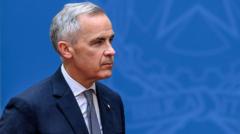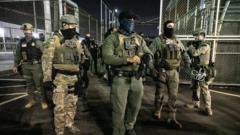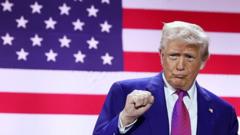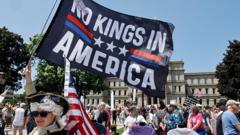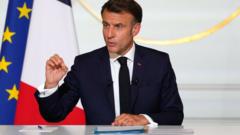On the eve of significant electoral change, the results of Canada’s federal election could redefine the political landscape amid challenges posed by foreign affairs and economic instability.
**Canada's Pivotal Election Night: Key Votes Shaping the Future**

**Canada's Pivotal Election Night: Key Votes Shaping the Future**
Canadians cast their votes amid a changing political landscape, influenced by international threats and rising domestic issues.
---
As the clock strikes 7:54 p.m. on April 28, 2025, Canadians are at the polls making crucial decisions about the country's leadership. Tonight’s election, fraught with complications, sees the first polls closing as citizens elect for their next Prime Minister at a pivotal moment governed by external pressures—most notably, the threats posed by U.S. President Donald Trump. Initial results are expected late Monday, providing insight into a race that saw former Conservative frontrunners fall behind as liberal sentiments surged.
This election marks not only a potential shift in leadership but also a critical resolution of the nation’s response to economic difficulties exacerbated by Trump's trade policies. Vying for the reins of power are Prime Minister Mark Carney of the Liberal Party, who has recently ascended following Justin Trudeau's resignation, and Conservative leader Pierre Poilievre, whose anticipation of victory was tempered by recent opinion polls showing a narrowing gap between the two parties.
Alongside the two main contenders are also runners from the New Democratic Party, the Greens, and the Bloc Québécois, though their expected parliamentary seats remain modest compared to the leading parties. Just three months prior, the Conservatives led by an impressive margin; with the sudden resignation of Trudeau and increasing discontent over Trump's contentious claims against Canada, the race's dynamics have swiftly shifted.
Voters are expressing varied sentiments tied closely to personal stakes. Prime Minister Mark Carney touts his economic expertise and centrist values as essential in safeguarding Canadian sovereignty and mitigating Trump's aggressive stance. In contrast, Pierre Poilievre’s strategies emphasize deregulation and a smaller government approach, drawing ire for his perceived alignment with Trump's policies amid rising anti-U.S. sentiment.
Poll results will yield major implications as the voting process utilizes manual ballot counting, contrasting with more rapid electronic methods in other nations. Canadians have already shown increased engagement, with over seven million participating in early polling—a 25% increase from the 2021 election.
As ballots are cast, the pressing question looms: who will lead Canada through these tumultuous times? The resolution will go beyond policy debates, reflecting the nation's collective sentiment towards sovereignty, economic stability, and the state of international relations. The stakes are undeniably high; as the polls close across the horizon, Canadians eagerly await their future leaders and the direction of their beloved country.
As the clock strikes 7:54 p.m. on April 28, 2025, Canadians are at the polls making crucial decisions about the country's leadership. Tonight’s election, fraught with complications, sees the first polls closing as citizens elect for their next Prime Minister at a pivotal moment governed by external pressures—most notably, the threats posed by U.S. President Donald Trump. Initial results are expected late Monday, providing insight into a race that saw former Conservative frontrunners fall behind as liberal sentiments surged.
This election marks not only a potential shift in leadership but also a critical resolution of the nation’s response to economic difficulties exacerbated by Trump's trade policies. Vying for the reins of power are Prime Minister Mark Carney of the Liberal Party, who has recently ascended following Justin Trudeau's resignation, and Conservative leader Pierre Poilievre, whose anticipation of victory was tempered by recent opinion polls showing a narrowing gap between the two parties.
Alongside the two main contenders are also runners from the New Democratic Party, the Greens, and the Bloc Québécois, though their expected parliamentary seats remain modest compared to the leading parties. Just three months prior, the Conservatives led by an impressive margin; with the sudden resignation of Trudeau and increasing discontent over Trump's contentious claims against Canada, the race's dynamics have swiftly shifted.
Voters are expressing varied sentiments tied closely to personal stakes. Prime Minister Mark Carney touts his economic expertise and centrist values as essential in safeguarding Canadian sovereignty and mitigating Trump's aggressive stance. In contrast, Pierre Poilievre’s strategies emphasize deregulation and a smaller government approach, drawing ire for his perceived alignment with Trump's policies amid rising anti-U.S. sentiment.
Poll results will yield major implications as the voting process utilizes manual ballot counting, contrasting with more rapid electronic methods in other nations. Canadians have already shown increased engagement, with over seven million participating in early polling—a 25% increase from the 2021 election.
As ballots are cast, the pressing question looms: who will lead Canada through these tumultuous times? The resolution will go beyond policy debates, reflecting the nation's collective sentiment towards sovereignty, economic stability, and the state of international relations. The stakes are undeniably high; as the polls close across the horizon, Canadians eagerly await their future leaders and the direction of their beloved country.











